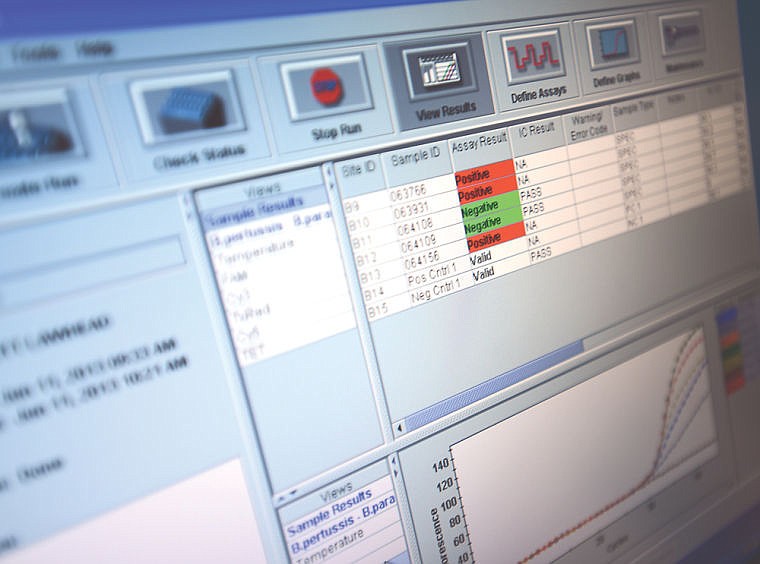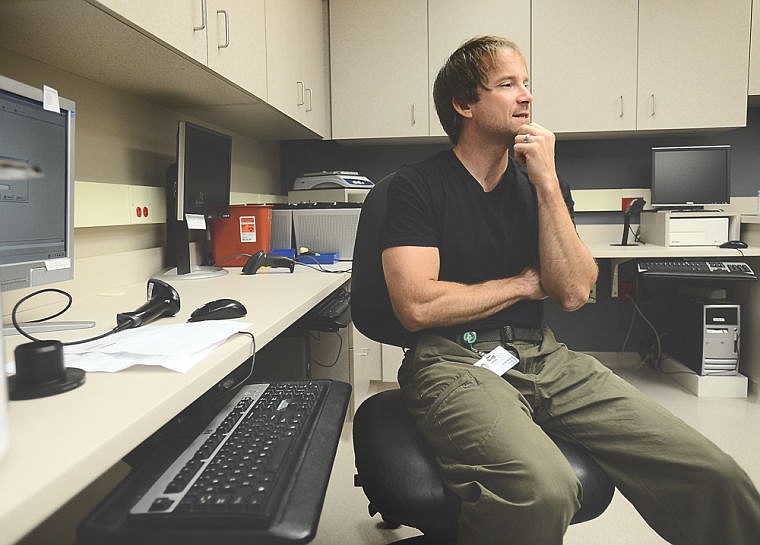Facility prides itself on speed
Ryan Murray | Hagadone News Network | UPDATED 12 years, 5 months AGO
Tucked away from the public, past where sunlight streams into the lobby of Kalispell Regional Medical Center’s new surgical center, several very smart men spend their days working with some rather nasty stuff.
They work in the climate-controlled molecular lab, a facility that uses hundreds of thousands of dollars’ worth of equipment to analyze biological samples on a cellular (and smaller) level.
When the lab opened in 2005, it received 1,000 to 2,000 samples yearly. Last year the lab looked at more than 26,000.
Molecular supervisor Adam Birks was there when the lab opened and has seen its benefit to the medical community of Northwest Montana.
“We’re able to offer new things that normally we would have to send off to somewhere else,” he said. “Every year we add about three to five new tests. We went through a pretty big expansion over the last year. Now it’s a catch-up time.”
The newest machine in the lab looks for sexually transmitted infections such as gonorrhea and chlamydia in biological samples.
Scott Lawhead, one of the clinical laboratory scientists, said they treat the nasty stuff they deal with professionally, but outside of work they have to have a humor about it.
“I tell my wife, ‘Oh we got chlamydia today at work,’” he said.
The lab also looks for norovirus, herpes, syphilis, rare bleeding disorders, influenza and other transmittable diseases.
The lab’s workload has spiked since last May, when the presence of the Bordetella bacteria shot up in Flathead County, causing a pertussis outbreak.
“We were doing 25 Bordetella (tests) a month, then we did 1,000 last May,” Birks said. “It’s never really dropped back down.”
The biggest benefit of the lab is the time it saves. Before the hospital opened the lab, doctors had to send samples to the state lab in Helena, which could take anywhere from five days to two weeks. The average turnaround time for Kalispell’s lab is 24 hours.
“Some days we’ll get a sample at 9 a.m. and have it back to the doctor by 5 p.m.,” Lawhead said. “Depending on the load, we can get it at 1 p.m. and still have it by 5 p.m.”
What does that mean? Patients get results faster and if they have something transmittable, they can take precautionary measures to avoid spreading it farther.
Joe Russell, Flathead County’s Public Health Officer, said the lab is a huge boon for the valley and Northwest Montana.
“Most people have to send samples off to the state,” he said. “It’s at least two days of benefit.”
Russell has been dealing with the pertussis (whooping cough) outbreak for more than a year, but the headache has been lessened by the fast turnover and sophisticated methods of KRMC’s molecular lab.
In particular, the lab can amplify genetic material to readily identify the genetic pattern. In essence, they extract DNA (or RNA) from a genetic sample, amplify it (from sub-microscopic to a size that can be read by machines) and then detect genetic anomalies.
Besides saving time from sample turnaround, the lab saves lives by detecting genetic mutations in cancer patients. Some common treatments for certain types of cancer have virtually no effect on those with a genetic mutation.
The lab tests people slated to undergo treatment to see if the common treatment will do anything.
“They can be given an expensive treatment and it might not work,” Lawhead said. “If our tests show they have the mutation, doctors won’t even waste time with the most common treatments.”
With all the good things the lab is doing with some gross stuff (working with stool samples and sexually transmitted infections is not the glamor job of the hospital), lab workers still deal with an old challenge.
“You see on the E.R. shows doctors always saying, ‘They’re waiting on the lab,’” Lawhead said. “Even though our turnaround time is 24 hours, we still get calls asking where the samples are.”
But Lawhead knows doctors are just trying to provide better care. And if they don’t like it, Helena has a weeklong waiting list if they would prefer that.
Reporter Ryan Murray may be reached at 758-4436 or by email at [email protected].
ARTICLES BY RYAN MURRAY

Eureka brewery turns heads with IPA
Off the beaten path, not far from the Canadian border, intrepid beer drinkers can find the best India Pale Ale in Montana — or at least the best according to the Montana Brewers Association.

Prep Tennis: Trojans romp at Bigfork tourney
The Trojan tennis teams crushed Valley Christian last Thursday 5-1 for the girls and a 6-0 sweep for the boys on their way to the Bigfork Tennis Tournament.
W.F. Morrison principal is fired; no reason given by board
In a surprising unanimous vote last Monday, the Troy School Board decided not to renew the contract of W.F. Morrison Principal Kelly Moore.





